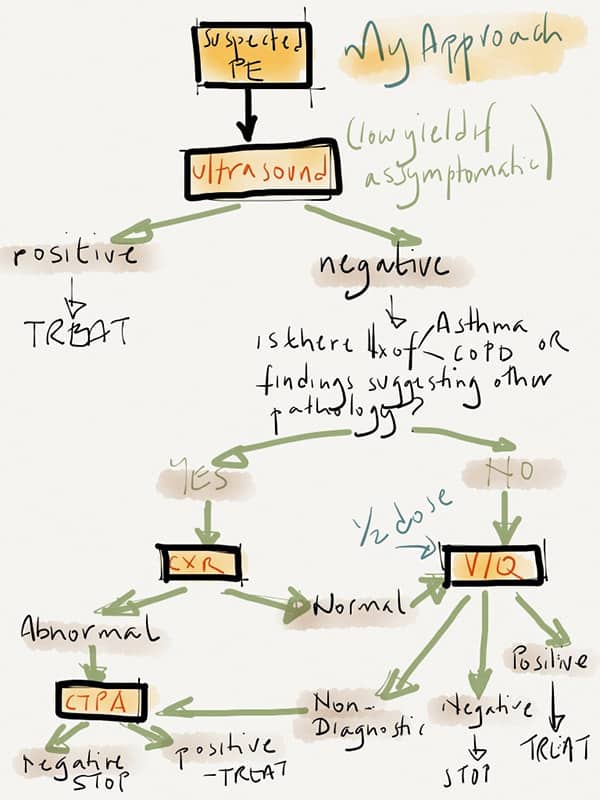OK here it is. The final word in investigating the pregnant patient with suspected pulmonary embolism.
Well, it’s my final word anyway. I’ve spent the last month or so reviewing the literature on this. What amazes me, is that two people can quote the same study and come up with a different conclusion.
The confusion appears to be totally related to what is acceptable radiation risk. There are two distinct risks, that to the mother and that to the fetus, and they are not equal.
Some clinical points of view indicate that we tell the mother the risks and ask her to make the decision, but I don’t believe that to be the right approach. It is our responsibility to know what is in the best interests of both the mother and fetus and to order the appropriate investigations.
Below is my approach.
Let me explain.
Introduction
PE is a leading cause of maternal death, the rate of PE in pregnancy being 5 times that in the non – pregnant patient.
What confuses us, is that signs and symptoms that accompany pregnancy, such as;
– shortness of breath
– tachycardia
– leg oedema
can also be present in patients with pulmonary embolism.
Gherman et al Obstet Gynecol 1999; 94; 730-734 found that in pregnant patients with confirmed PE
– 62% had dyspnoea
– 50% had pleuritic chest pain
– 24% had cough
– 18% had sweating
but this was a very smallstudy (n=38)
What about the PERC rule and Wells score?
Here’s the problem. The Wells score cannot be used as pregnant patients were excluded from the validation study.(Ann Int Med 2001 135:98-107).
Speaking generally, our gestalt will tells us, purely based on the signs and symptoms on presentation and the fact that the patient is pregnant, that the risk is higher in this patient group; remember five times the risk in a non-pregnant patient. This automatically raises the risk to, or above 15%.
Can we use D-dimer?
D-dimer is usually normal in the first trimester, rises in the second trimester and returns to normal 4-6 weeks post partum.(Clin Chem 2005; 51:825-9)
There is a move to increase thresholds of D-dimer for each trimester in pregnancy, so that the D-dimer can be used. However, beware, the evidence is not great. Damodaram et al J Obstet Gynaecol 2009; 29:101-103, in a small retrospective study looked at patients with suspected PE who had both a V/Q and a D-dimer. The results indicated that a negative D-dimer could not rule out PE. There are also multiple case reports of false negative D-dimers.
I personally, currently, in the pregnant patient, given their increased risk of PE, will not rely on D-dimer.( D-dimer blog coming soon)
V/Q, CTPA, MRA, Ultrasound and chest X-ray
Let me say at the outset, that currently MR pulmonary angiograms are not considered. Firstly there have, to my knowledge, not been any studies done in the pregnant patient. Secondly, although we know, like iodinated contrast agents, gadolinium also crosses the placenta, we are really unsure of its effect on the fetes and even though there have been no adverse fetal effects reported from Gadolinium, the studies done are few.
In terms of sensitivity and specificity, the MR angiogram approaches that, but may not be as good as, CTPA(AJR 2006 Jul; 187(1):109-114).
What about the ultrasound?
The ultrasound can and should be the first investigation performed. It is simple, non-invasive and does not expose the patient to any ionizing radiation. Approximately 70% of patients with PE have proximal deep vein thrombosis. We do not actually know the prevalence of DVT in pregnant patients presenting with a suspected PE.
We do know that the prevalence of DVT in those patients without symptoms is low. However if you, suspect a PE and find a DVT on ultrasound you’re done.
Is there a place for chest X-Ray?
My view is that there is no major role for this investigation in the diagnosis of PE. There are no real sensitive or specific findings for a PE on chest x-ray. Sure you say there’s the Westermark sign etc., but how often do we see this and even if you do, you will not make the diagnosis based on them.
The chest x-ray may be of use for those undergoing PE, to allow correlation of findings.
What about the V/Q scan?
The major concerns with V/Q scans have been that, in the general population, up to 70% of scans are indeterminate.
The pregnant patient however, does not fall into the normal population group. In the pregnant patient less than 5% of scans are highly probability and 75% of scans are normal.(Arch Int Med 2002; 162:1170-5). This is probably as a result of this population group being younger, with less co-morbidities. This means that only about 20% of V/Q scans are indeterminate.
The radiation dose of the V/Q scan varies from 0.32 to 0.74 mGy, to the fetus. It is constant for all trimesters. This dosage(in fact, all dosages less than 50mGy) pres risk of prenatal death, malformation, or abnormal mental development. Central nervous system malformations, occur at doses of 100,000mGy to 200,000mGy.
Doses of 100mGy result in approximately 1% chance of childhood cancer(Radiographics 2002, 22:909-918) ie, 200 times the average dose of a V/Q scan.
The radiation dose can be further reduced, by using a half dose perfusion scan. Detection of a defect means no ventilation scan is required.
In the mother, the malignancies we are concerned about, are related to lung and breast. The maternal whole body radiation dose of a V/Q scan is 1-2.5 mSv. 1millisievert(mSv) is the dose produced by exposure to 1 milligray(mGy) of radiation.
The radiation dose to breast tissue is 0.28-0.5mSv(Europ Radiol 2003; 13:1515-1521)
The lifetime risk of breast cancer from 20mGy is
– 1/1200 women at age 20
– 1/2000 women at age 30
– 1/3500 women at age 40
The lifetime risk of breast cancer is 1/8.
Perfusion only V/Q scans significant;y reduce exposure. Scarbrook et al Eur Radiol 2007:17:2554-2560 reported on the use of perfusion-only scans and found a 100% negative predictive value of PE for scans other than high probability.
What about CTPA?
With the increase availability of CT scanners, it is very simple to perform a CTPA.
It has a high sensitivity and specificity. A negative predictive value for PE following a normal scan is >99%(JAMA 2005; 293:2012-7)
In a retrospective study comparing CTPA and V/Q by Shahir et al Am J Roentg 2010; 195:W214-220 found a negative predictive value of 99% and 100% respectively.
The fetal radiation dose increases with each trimester, from 3.3mGy to 130mGy. In terms of fetal radiation exposure, there is a trend that favours CTPA for the 1st and second trimesters of pregnancy(BMJ 2005; 331:350)
The concern with CTPA is the maternal radiation dose.
|
maternal dose |
lung |
breast |
|
| CTPA | 39.5mGy | 10-60mGy | |
| V/Q | 5.7-13.5mGy | 0.98-1.07mGy |
(Cook et al BMJ 2005; 331:350)
The literature on maternal risk of cancer can be confusing.
There is evidence that greater than 1000mGy is associated with a 40% increase in the risk of breast cancer. We are told that there is no increased risk at below 200mGy(Lancet 2010; 375:500-512). The CTPA radiation dose doesn’t come anywhere near this.
We do however know that there is an increased risk of breast cancer in over 35 year olds with a 10mGy dose to the breast. We also know that the overall, lifetime risk of breast cancer is 0.7% (JAMA 2007; 298:317-23) Further, the predictive models that we have show a higher lifetime risk of radiation induced cancer from a CTPA rather than a V/Q scan.
Conclusion
Given that the fetal exposure is actually small, the determination as to which modality to use rests with the maternal risk. Given that there is a significant risk of cancer to the mother the V/Q scan is preferred to the CTPA.
Ultrasound should be performed first, if negative proceed to a V/Q scan, unless there is some lung pathology that will affect the quality of the V/Q. Use a half dose perfusion scan. If a ventilation scan is required discuss the use of Xenon-133 instead of Technetium-99m. Also consider a catheter to drain the contrast. The limitation is often that V/Q is not available in the smaller centres. The decision then may become easier.
If a CTPA is needed, one size does not fit at all. The technical parameters may be adjusted for the size of the woman. The use of appropriate shielding, such as breast shields, can decrease the exposure significantly.
Peter Kas












Diane Campbell sent me this email, which is good feedback for you to read:
PA only CXR is trivial radiation & one would look a right idiot if a pneumothorax was missed and diagnosed only on CTPA! And yes, of course one can miss it clinically. I wish our otherwise excellent xray facility would stop doing PA and lateral for everything tho.
Surprised you mentioned perfusion only scan then still recommended V/Q. One BMJ article made the sensible suggestion of perfusion only and continue to ventilation if necc which it generally wasn’t – as you said, they all have normal pre-morbid lungs. (it was in the “for debate” section but I can’t find it – fairly old, I admit. ) One of my concerns is that these women are not infrequently repeat attenders, which means the breast radiation dose goes up. What Australia is NOT good at doing is keeping tabs on peoples lifetime exposure. I saw a wonderful suggestion in a BMJ editorial or letter which said, the writer’s practice was to add at the bottom of EACH radiology report the estimated radiation dose of the exam. Simple, cheap, why don’t we do that??!. (“Its the clinician’s decision to get the examination and to know about radiation doses ” I was told when I brought it up locally.)
Catheters aren’t popular, fluid load and telling the woman to go immediately afterwards & to drink enough to void every 30 mins not quite as effective but might be more likely to get done.
Great email thanks.
My question is if we are so concerned about radiation to mother and not fetus do we ever think what investigation should we do to diagnose PE in non pregnant young woman on contraceptive pill . USS or V/q scan and not CTPA probably not. So why are we so concern about maternal radiation in pregnant woman ?
I agree
Interesting article- thank you for posting. I have a quick respectful correction- your fetal dose from the CTPA should actually read 3.3-130 microGy and not milliGy.
V/Q or CTPA in suspected PE in pregnancy – Resus
jnkcdbxi http://www.gb09yw60o8024y0iqfnxo3zd5g1x0455s.org/
[url=http://www.gb09yw60o8024y0iqfnxo3zd5g1x0455s.org/]ujnkcdbxi[/url]
ajnkcdbxi
Crayon With Plastic Tube
Analgesia Infusion Pump
Batteries Powered Lights
コーチ財布スーパーコピーコーチブランド専門店
Manganese Test Strips
LouisVuittonルイヴィトン財布スーパーコピー
Automatic Pierogi Machine For Sale
Chanelシャネルバッグスーパーコピー
Faber
ブランドBvlgariブルガリブレスレットコピー代引き
Aluminium Led Display Cabinet
Diorディオールサングラス販売店
Chaga Liquid Extract
Sidelifter Container
Balenciagaバレンシアガバッグ販売店
Elevator Gate Door
ブランドSaintLaurentサンローラン財布コピーN級品
Butterfly Valve Lock
ブランドコピー専門店
日本国内発送通販ブランドコピー安全後払い専門店
Bfl413 Engine Parts
ブランドコピー専門店
Inverted Umbrella
Electric Tricycles In Cuba
ブランド財布コピー
ブランドコピー専門店
China Pubg Mobile Controller Trigger
5/16 Spiral Reamer
ブランドバッグコピー
City Commuter Electric Bike
コピー時計
China Slimming Coffee
コピー時計
スーパーコピーバッグ
China Reducer
スーパーコピーバッグ
Aluminum Heatsink
Flushable Wipes For Sensitive Skin
ブランドLouisVuittonルイヴィトンベルトコピー代引き
Climbing Ladder Upper And Lower Support Sale Price
ブランドスマホケース販売店
LouisVuittonルイヴィトン靴販売店
disabled portable toilet
Glass Polishing Machinery
Cartierカルティエスーパーコピー
Attack Head Flashlight Supplier
ブランドCartierカルティエサングラスコピー代引き
Hermesエルメス指輪コピー
China 1080p Pc Gaming Monitor
ブランドコピー専門店
mudguard
Diorディオールイヤリング販売店
Na2co3 Soda Ash
Hand Sanitizer Stations
ブランドChanelシャネルブレスレットコピー代引き
IP Network
スーパーコピーブランド
Bamboo Storage Box Drawer Organizer
Bvlgariブルガリスーパーコピー
スーパーコピーバッグ
Solar Led Display Trailer
Ladies Long Raincoat
ブランド財布コピー代引き
ブランドFendiフェンディ財布コピー代引き
Crimp Cable Lug
360 Water Faucet
ブランドバッグコピー
Carbide Block
スーパーコピーバッグ
Pe Foam Insulation
ブランドコピー代引き
Petg Erlenmeyer Flasks with Vented Cap
A Guide To Office Lighting
ブランド時計コピー
Dispensing Software
Onesette Tissue Cassettes
ブランドバッグコピー
ブランドコピー代引き
Stamping
2816423700